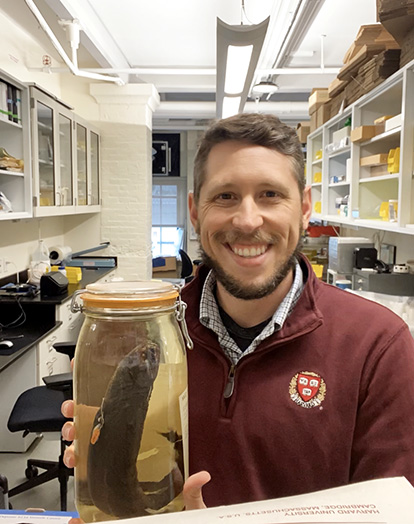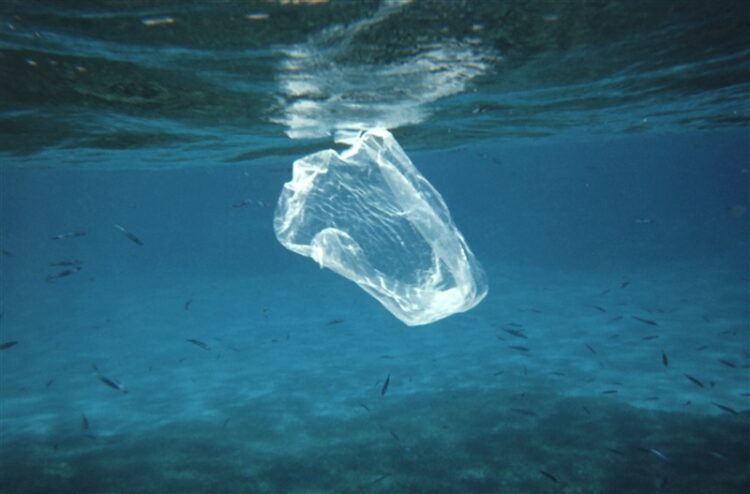By Hannah Brown
Below the surface of the Gulf of Mexico, up to 5,000 feet deep, as light fades into dark ocean waters, tiny particles of plastic rain down, showering the water column and settling in sediments on the ocean floor.
Small fish and crustaceans dine on these microplastics, which are often slathered in colonies of bacteria. And in a surprising twist: the deeper they live, the more plastic these tiny animals eat.
These are the results of a paper recently published in the journal of “Limnology and Oceanography.” The study was conducted as part of the DEEPEND deepwater survey of fish and other marine organisms, which was funded by the NOAA RESTORE Science Program in 2019.
Microplastics, or plastic particles smaller than 5 millimeters, have been found across the world’s oceans, from the surface to the ocean floor and in sea ice. These tiny plastic particles are the result of larger plastic materials breaking down, such as bottles, plastic bags, and clothes made from polyester and other plastic fibers. Plastic materials are often discarded on land and then carried by rivers or winds to the ocean. One study estimated that in 2016 up to 23 million tons, or 11% of global plastic waste, entered aquatic ecosystems that year.

But while it’s clear that microplastic particles are prevalent across the world’s oceans, researchers have many questions on how animals in the deep ocean interact with them.
Ryan Bos, the lead author of the microplastic ingestion study, first developed an appreciation for aquatic life as a young boy boating with his father and brother in the lakes of Illinois.
“As we started to leave the dock on this boat, I would see this beautiful underwater landscape. And as you go deeper, it starts to fade from view, “ Bos said. “I always wondered what else could be down there, and it really sparked this curiosity in me. Not surprisingly, I was drawn towards doing deep-sea research.”
Bos went on to earn a master’s degree from Nova Southeastern University and a doctorate from Florida Atlantic University. He is now a postdoctoral fellow at Harvard University continuing his work on microplastics in marine environments.
“We just don’t know where it’s all going,” Bos said. “In fact, 99% of all plastics that have ever been manufactured are currently unaccounted for, which is partly the inspiration for doing this microplastic ingestion study, as midwater biomass [organisms in the mid-ocean] may be a temporary reservoir for plastic pollution.”
Beginning in 2015, Bos joined DEEPEND deepwater cruises in the Gulf of Mexico with the goal of better understanding microplastic ingestion in the fish and crustaceans of the deep Gulf. Bos and his team collected 557 organisms from 35 different species, some of which came from a research cruise that surveys the North Atlantic Ocean. As they collected each specimen, they took note of the depth they were found, from 0 to 5,000 feet deep.

The stomach contents of each organism were processed and assessed for the extent of plastic ingestion, and then a portion of plastic particles were chemically analyzed to see what kinds of plastics were being devoured.
Bos and his team found that 29% of crustaceans and 26% of fish collected had eaten at least one microplastic particle. Fish and crustaceans that stay put in deeper parts of the ocean without migrating up to shallower depths had ingested more microplastics than organisms collected at shallower depths. This was particularly true for animals collected from 4,000 to 5,000 feet deep.
“It’s really alarming to think that these non-migratory organisms, that are thought to remain relatively quiescent [inactive] at depth for their entire life, are being exposed to plastic,” Bos said.
The primary types of microplastics found in their stomachs were small fragments of cellophane, or clear plastic film often used in food and cosmetic packaging, and fibers that likely derived from ship paint resin. They also found that the crustaceans were more likely to eat fibers, while the fish more often ate fragments.
Microplastics for Dinner
But how are these tiny plastic particles making their way to such depths? Bos’ study found that microplastics could be making their way to the deep ocean through marine snow, the term used to describe the shower of decaying matter, sand, and other dust-like materials that continuously falls from the surface of the ocean. Animals in the deep ocean rely on these flakes of debris for energy.
The animals in Bos’ study were likely scavenging plastic flakes from marine snow in the water column – the crustaceans in particular were especially adept at this. Some studies suggest that animals may be attracted to oxidized plastic particles, seeking them out after they have been weathered and colonized by bacteria and other microorganisms.
“I think that’s a reasonable idea to suggest that animals, particularly myctophids [commonly known as lanternfishes], which are selective particle feeders, can selectively consume plastic from the water column,” Bos said. “It’s also plausible that these animals are tricked into consuming plastic because of bioluminescence from bacteria adhered to plastics, which could illuminate these ‘prey’ items in an otherwise light-deprived environment. Plastics may also leach certain compounds that their olfactory system [sense of smell] is picking up. But that still remains to be determined here.”



Once microplastics have been consumed, it’s not clear exactly how the presence of plastic inside animal bodies affects their health, especially in the small deepwater animals Bos studied. But previous research on larger species has found evidence of a myriad of health impacts from ingesting microplastics, including reduced swimming speed, impaired reproduction rates, increased stress levels, reduced absorption of nutrients, and death.
“It can cause physical damage. Eating plastic fragments with sharp edges or points to it can tear tissue,” said Amy V. Uhrin, chief scientist for NOAA’s Marine Debris Program.
On top of the physical damage, researchers are also concerned about chemical contamination from ingesting plastics.
“Plastics are infused with a lot of different chemicals for different reasons: to give them colors, make them rigid, make them more pliable, to serve as flame retardants,” Uhrin said. “But when plastics get into the environment, there are also persistent organic pollutants that can adhere or adsorb to the surface of the plastic. So then you have this sort of chemical cocktail that can also enter the animal after it’s ingested.”
Uhrin said that studying the impacts of these chemicals is incredibly challenging because their composition varies so widely. “Some of those chemicals are proprietary, so you don’t really know what’s in there,” she said.
Though there are only a handful of studies assessing microplastic impacts on the ocean’s food webs, it’s likely that these plastic particles build up in larger organisms as well – both from eating smaller organisms that have consumed plastic and from directly ingesting it themselves.
“It’s highly likely that there’s biomagnification of plastic that’s occurring in the food web, ” Bos said. “For organisms that are predating on lanternfishes, for example, if there’s 26% of lanternfishes in our study ingesting plastic, you’d have to imagine that at least once one of these animals could be consumed by a larger pelagic [open ocean] organism, and plastic could be passed up the food web.”
Connecting the Microplastic Dots
This question of how microplastics could potentially impact food webs and the surrounding environment is of special interest to the natural resource managers who are tasked with making decisions on how marine species and their habitats are managed.
Ebenezer Nyadjro is a physical and satellite oceanographer who works with NOAA’s National Centers for Environmental Information (NCEI) to create a database of existing datasets documenting microplastics in the world’s oceans. Nyadjro and his team also created a Marine Microplastics Map Viewer to visualize the massive amounts of data they have collected.
“We currently have about 37 datasets made up of about 14,000 data points,” Nyadjro said.

The database is unique in that it is the most comprehensive microplastic database for international waters, and it is growing. Right now, the database only includes microplastics that were found floating on the surface of the ocean, but soon it will be updated to look at data from beneath the surface, in sediments, and on the coast.
“The updates we are going to do is going to move it from one map layer to five,” Nyadjro said.
Jennifer Webster, an oceanographer with NOAA NCEI who oversees the development of the database, said the goal of this project is to make global microplastic measurements freely available to the world so that scientists can tackle the growing problems associated with them. But the portal is also tailored to meet the needs of natural resource managers and concerned members of the public.
“There are people that are looking for data to do applied things like manage the environment, manage natural resource areas, and these are data that are becoming increasingly important to them,” Webster said. “It’s a growing problem. I think that the data that we’re collecting now will give those environmental managers a starting point of knowing whether or not microplastics have been found in their area.”
A World of Questions for a Growing Problem
The amount of macro and microplastics entering global aquatic ecosystems each year is expected to more than double by 2040 if no changes are implemented on how we produce, use, and dispose of plastic, according to a report by the PEW Charitable Trusts. The report also emphasized that 80% of plastic pollution in the ocean could be prevented with existing solutions and technologies.
“The issue of plastics crosses so many different scientific disciplines and requires a lot of interdisciplinary work that it just becomes very complicated,” Uhrin said.

In recent years, Uhrin has seen advances in research examining how plastic impacts marine animals. She sees researchers beginning to consider population-level impacts, as well as how microplastics affect multiple species in an ecosystem instead of just one individual at a time.
“You have to scale that up because we’re not managing for a single fish or a crab, we’re managing the whole population,” Uhrin said.
She still sees opportunity for improvement with microplastic research, however, especially in the types and concentrations of microplastics that animals in the lab are exposed to – previous studies have tended to “superdose” lab specimens with concentrations of plastic that are not representative of what would be found in natural habitats.
In his current postdoctoral fellowship, Bos also sees a world of questions to be answered on microplastics and their impacts, with his eyes always turned to what lies in the deep ocean.
For him the key questions are still: Where does all the plastic ultimately go? Do smaller plastics remain suspended in the open ocean for long time periods, or do they all end up getting buried in sediments on the ocean floor? And if so, how do they get there?
Cover image: An anemone entangled in plastics on the deep-sea floor. Photo by Tamara Frank, Nova Southeastern University
 Official websites use.gov
A .gov website belongs to an official government organization in the United States.
Official websites use.gov
A .gov website belongs to an official government organization in the United States.
 Secure .gov websites use HTTPS
A lock or https:// means you’ve safely connected to the .gov website. Share sensitive information only on official, secure websites.
Secure .gov websites use HTTPS
A lock or https:// means you’ve safely connected to the .gov website. Share sensitive information only on official, secure websites.